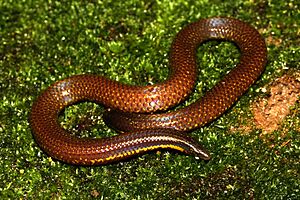Elliot's earth snake facts for kids
Quick facts for kids Elliot's earth snake |
|
|---|---|
 |
|
| Conservation status | |
| Scientific classification | |
| Genus: |
Uropeltis
|
| Species: |
ellioti
|
Uropeltis ellioti, also known as the Elliot's earth snake or Elliot's shieldtail, is a special kind of snake. It belongs to a group of snakes called Uropeltidae, which are known for their unique tails. This snake is found only in India, meaning it's endemic to that country.
Contents
What's in a Name?
The scientific name, ellioti, was given to honor a Scottish naturalist named Walter Elliot. He was a keen observer of nature.
Where Does It Live?
The Elliot's earth snake lives in southern India. You can find it in the hills of Peninsular India, especially in the Western Ghats south of the Goa Gap. It also lives in parts of the Eastern Ghats, including areas like Shevaroys and Coimbatore.
Scientists first found this snake near Chennai (formerly Madras) and in the Pulney hills.
Home Sweet Home: Habitat
This snake prefers to live in forests. It can be found at different heights, from about 100 meters (330 feet) up to 1,400 meters (4,600 feet) above sea level.
What Does It Look Like?
The Elliot's earth snake is usually dark brown on its back. It might have small yellow dots or be plain brown. It has a yellow stripe on each side of its neck and another yellow stripe on each side of its tail.
Its belly is dark brown with tiny yellow dots. There's also a yellow bar across its belly near the tail, which connects the yellow stripes on its tail.
Adult snakes can grow to about 24 centimeters (9.4 inches) long, including their tail.
Its body is quite slender, meaning it's long and thin. The end of its tail can be rounded or a bit flat on top. The scales on its tail have strong ridges, and the very last scale on its tail has a ridge and two small points.
How Does It Behave?
The Elliot's earth snake spends its life on the ground. It is also fossorial, which means it's good at digging and lives mostly underground.
What Does It Eat?
This snake is a predator, and its main food source is earthworms. It hunts them underground.
Reproduction
The Elliot's earth snake is ovoviviparous. This means that the mother snake keeps the eggs inside her body until they hatch. The babies are born live, rather than the mother laying eggs outside her body.


